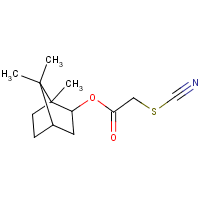Isobornyl thiocyanoacetate
Agent Name
Isobornyl thiocyanoacetate
CAS Number
115-31-1
Formula
C13-H19-N-O2-S
Major Category
Pesticides

Synonyms
1,7,7-Trimethylbicyclo(2,2,1)hept-2-ylthiocyanatoacetate; 1,7,7-Trimethylnorbornan-2-yl thiocyanoacetate; Acetic acid, thiocyanato-, 1,7,7-trimethylbicyclo(2.2.1)hept-2-yl ester, exo-; Acetic acid, thiocyanato-, isobornyl ester, exo-; Bornate; Cidalon; ENT 92; Isoborneol, thiocyanatoacetate; Isobornyl thiocyanatoacetate; Isobornyl thiocyanatoacetate, technical; Isobornylester kyseliny thiokyanatooctove [Czech]; Terpinyl thiocyanoacetate; Thanisol; Thanite; Thanite (hercules powder); Thiocyanatoacetic acid 1,7,7-trimethylbicyclo(2.2.1)hept-2-yl ester; Thiocyanatoacetic acid isobornyl ester; exo-1,7,7-Trimethylbicyclo(2.2.1)hept-2-yl thiocyanatoacetate; [ChemIDplus]
Category
Other Insecticides
Description
Technical grade: Yellow oily liquid; Contains up to 18% other terpenes; [Merck Index] Yellow, reddish-yellow, or amber liquid; [HSDB]
Sources/Uses
Used as a non-systemic contact insecticide for rapid 'knockdown" of flies primarily in domestic and livestock fly sprays; as fungicide to preserve industrial products such as glue, leather, paints, dyes, paper, and synthetic textile materials; for immobilizing grass carp, green sunfish, and channel catfish for live capturing; as a space spray (7%) in buildings; for control of head lice; against fleas and lice on pets; No longer registered with the EPA for use in the US, cancelled; [HSDB]
Comments
Highly irritating; [Hawley] A strong skin, eye, and mucous membrane irritant; Poisoning is due to release of cyanide ion; Repeated dermal doses of 1000 mg/kg/day was fatal to rabbits after 4-5 doses; A fatal human case after ingestion reported--shock, unconsciousness, and death within 8 hours; Aliphatic thiocyanate poisoning may include injury to liver and kidneys; [HSDB]
Biomedical References
Exposure Assessment
Vapor Pressure
2.5E-05 mm Hg
Adverse Effects
Hepatotoxin
Hepatoxic (a) from occupational exposure (secondary effect) or (b) in animal studies or in humans after ingestion
Other Poison
Chemical Asphyxiant
Diseases, Processes, and Activities Linked to This Agent
Processes
Industrial Processes with risk of exposure: